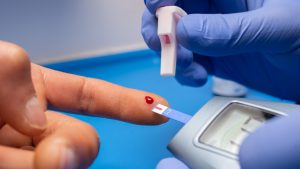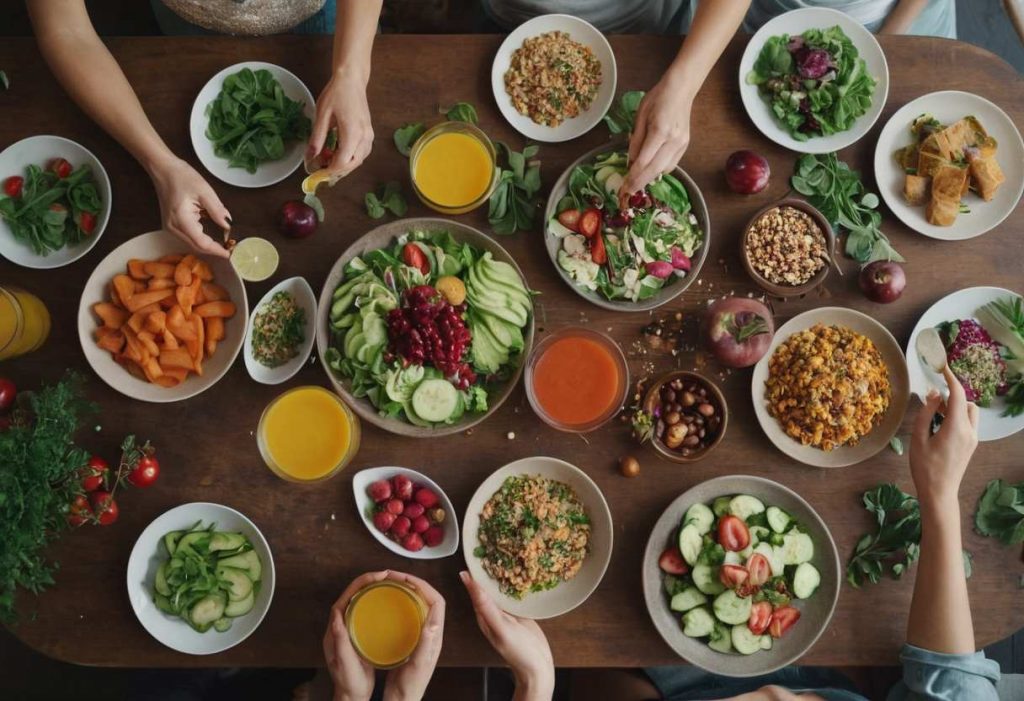Thanksgiving is a time to gather with loved ones, express gratitude, and enjoy delicious food. For those following a vegan lifestyle and managing diabetes, crafting a festive and healthy menu is easier than you think. Here are five completely plant-based, diabetes-friendly dishes that will be a hit at any Thanksgiving table!
1. Herb-Roasted Veggie Platter 🥦🍠
A vibrant centerpiece full of flavor and nutrition!
Ingredients:
- 1 cup Brussels sprouts, halved
- 1 cup butternut squash, diced
- 1 red bell pepper, sliced
- 1 zucchini, sliced
- 2 tablespoons olive oil
- 1 teaspoon fresh thyme
- 1 teaspoon rosemary
- Salt and pepper to taste
Directions:
- Preheat the oven to 400°F (200°C).
- Toss the vegetables with olive oil, thyme, rosemary, salt, and pepper.
- Spread evenly on a baking sheet and roast for 25-30 minutes, stirring halfway.
- Serve warm and garnish with fresh herbs.
Why it’s great: This colorful dish is packed with fiber, vitamins, and natural sweetness without added sugars.
2. Creamy Cauliflower Mash 🥔✨
A creamy, comforting side that’s completely plant-based.
Ingredients:
- 1 head cauliflower, cut into florets
- ¼ cup unsweetened almond milk
- 2 tablespoons nutritional yeast
- Salt, pepper, and garlic powder to taste
Directions:
- Steam cauliflower until tender, about 10 minutes.
- Blend in a food processor with almond milk, nutritional yeast, and seasonings until smooth.
- Serve as a creamy alternative to mashed potatoes.
Why it’s great: This low-carb dish is rich in flavor and provides a healthy dose of nutrients.
3. Savory Quinoa-Stuffed Acorn Squash 🎃
A show-stopping main course filled with wholesome goodness.
Ingredients:
- 2 medium acorn squashes, halved and seeds removed
- 1 cup cooked quinoa
- ¼ cup dried cranberries (unsweetened)
- ¼ cup chopped pecans
- 1 teaspoon cinnamon
- 1 teaspoon olive oil
Directions:
- Preheat the oven to 375°F (190°C).
- Brush the squash halves with olive oil and roast cut-side down for 20 minutes.
- Mix quinoa, cranberries, pecans, and cinnamon in a bowl.
- Fill the roasted squash halves with the quinoa mixture and bake for another 10 minutes.
Why it’s great: Quinoa provides protein and fiber, making this dish hearty and satisfying.
4. Maple-Roasted Carrots 🥕
Sweet, savory, and bursting with flavor!
Ingredients:
- 1 pound carrots, peeled and sliced
- 1 tablespoon olive oil
- 1 tablespoon sugar-free maple syrup
- ½ teaspoon smoked paprika
- Salt and pepper to taste
Directions:
- Preheat oven to 400°F (200°C).
- Toss carrots with olive oil, maple syrup, paprika, salt, and pepper.
- Spread on a baking sheet and roast for 20-25 minutes, stirring once.
Why it’s great: This simple dish adds natural sweetness and a touch of warmth to your Thanksgiving spread.
5. Dairy-Free Pumpkin Pudding 🥧
A creamy, spiced dessert perfect for the season.
Ingredients:
- 1 cup pumpkin puree
- ½ cup coconut milk
- 2 tablespoons chia seeds
- 1 tablespoon sugar-free maple syrup
- 1 teaspoon cinnamon
- ½ teaspoon nutmeg
Directions:
- Mix all ingredients in a bowl until well combined.
- Cover and refrigerate for at least 4 hours or overnight to thicken.
- Serve chilled and garnish with a sprinkle of cinnamon.
Why it’s great: This dessert is naturally sweetened and loaded with fiber, making it a guilt-free treat.
Final Thoughts 🎉
Thanksgiving doesn’t have to be a challenge for vegans managing diabetes. With these creative and wholesome dishes, you can enjoy a feast that’s as satisfying as it is healthy. These recipes are proof that a plant-based Thanksgiving can be flavorful, festive, and inclusive for everyone at the table.
Let’s give thanks for good food and great health this holiday season! 🧡
Would you like printable versions of these recipes? 😊

Type 2 Diabetes: Is It Really Reversible?
A recent National Geographic article [link] explores how type 2 diabetes could be reversible with the right approaches. This condition, which affects millions of people worldwide, has long been considered a chronic and progressive disease. However, recent research challenges this perception and suggests that with lifestyle changes and the right approach, remission is possible. The

How Do GLP-1 Drugs Compare? A Breakdown of Ozempic, Mounjaro, and Trulicity
GLP-1 receptor agonists have revolutionized diabetes management, with drugs like Ozempic, Mounjaro, and Trulicity leading the market. But how do these medications compare in terms of effectiveness, side effects, and patient outcomes? Let’s explore their differences and what they mean for diabetes patients. Understanding GLP-1 Medications GLP-1 receptor agonists mimic a natural hormone that helps

Why Has Medicare Spending on Diabetes Medications Skyrocketed in 5 Years?
In the past five years, Medicare spending on diabetes medications has increased nearly fivefold, reaching $35.8 billion in 2023. This surge has been primarily driven by the growing use of GLP-1 drugs such as Ozempic, Mounjaro, and Trulicity. But what is behind this cost escalation, and how does it affect patients and the U.S. healthcare

The Gut Microbiota and Blood Sugar Control: A Hidden Connection
The human gut is home to trillions of bacteria that play a crucial role in digestion, immune function, and even metabolism. Recent research has revealed a fascinating link between the gut microbiota and blood sugar regulation, shedding light on how the balance of microbes in our intestines can influence diabetes risk and overall metabolic health.

The Dawn Phenomenon: Why Blood Sugar Rises While You Sleep
For many people with diabetes, waking up with high blood sugar levels can be frustrating—especially if they didn’t eat anything overnight. This early-morning spike in blood glucose is known as the Dawn Phenomenon, and it happens due to natural hormonal changes in the body. But why does it occur, and how can it be managed?

The Influence of Red Light on Blood: Can It Improve Diabetes?
Type 2 diabetes is a metabolic disease characterized by insulin resistance and elevated blood glucose levels. In the search for complementary alternatives to improve glycemic control, red light therapy has gained attention due to its potential to enhance circulation, reduce inflammation, and optimize cellular function. But what does science say about it? ✨ What is

